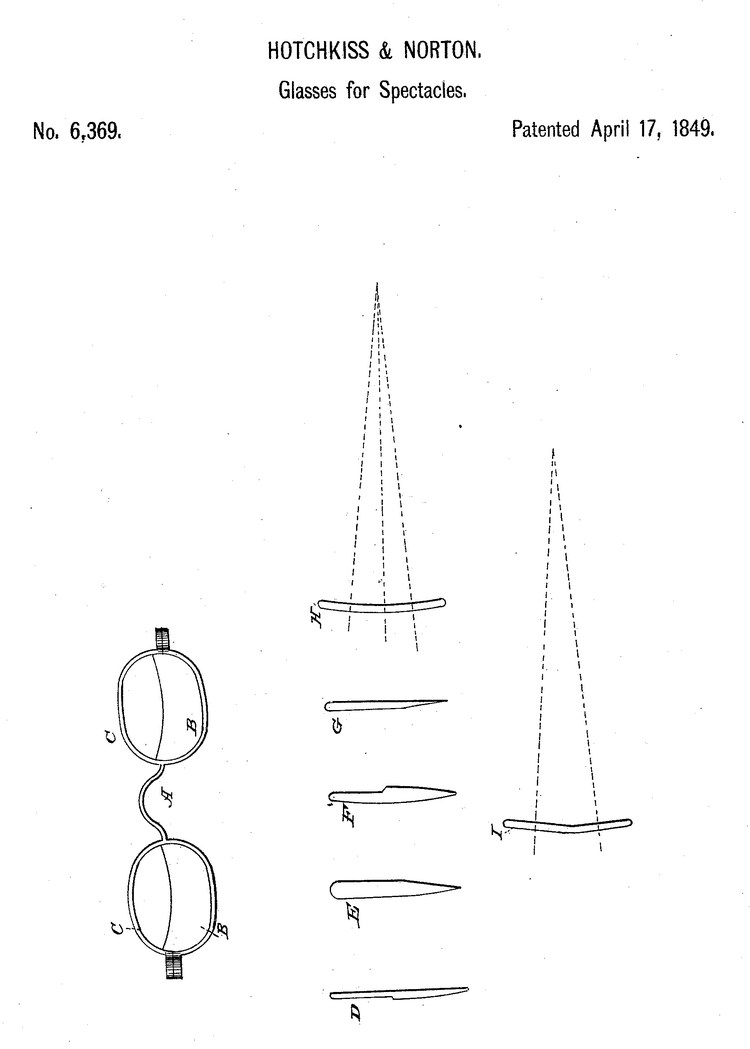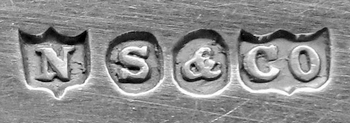David Hotchkiss
- Born: 5 Nov 1796, Woodbury CT
- Marriage (1): Rachel Norton on 12 Feb 1824 in Woodbury CT
- Marriage (2): Julia M. Howard on 25 Mar 1852 in Syracuse NY
- Died: 1 Sep 1874, Syracuse NY
General notes:
Silversmith and jeweler
Events in his life were:
- He worked as a silversmith and jeweler in 1825-1840

- He was issued patent number 6,369 on 17 Apr 1849
DAVID HOTCHKISS AND BENJAMIN R. NORTON, OF SYRACUSE, NEW YORK.
SPECTACLE-GLASS.
Specification of Letters Patent No. 6,369, dated April 17, 1849.
To all whom it may concern :
Be it known that we, David Hotchkiss and Benjamin R. Norton, of the city of Syracuse, in the county of Onondaga and State of New York, have invented a new and useful Improvement in Glasses for Spectacles; and we do hereby declare the following to be a full, clear, and exact description of the construction and operation of the same, reference being had to the annexed drawing, making part of this specification.
The nature of our invention consists in so constructing glasses for spectacles, that the upper portion is adapted to viewing objects at a distance and the lower portion to viewing objects near the eye.
In the annexed drawings, A represents a pair of spectacles having the lower portion (B) of the glasses convex, and the upper portion (C) a plane.
(D) is a vertical section of a glass having its upper portion a plane, and its lower portion a piano convex.
(E) is a section of a glass having its upper portion a plane and its lower portion a double convex.
(F) has its upper portion a piano convex, and its lower a double convex.
(G) has its upper portion plane, and its lower piano convex.
(H) represents a vertical section of a glass having its upper portion plane, and its lower a concavo convex, and so bent that the line of either portion forms an angle with that of the other at the center.
(I) is a section of a glass having its upper portion a plane, and the lower portion a piano convex, both inner surfaces being plane and forming an angle with each other of about 10 degrees.
The forms shown at D and F may be made by grinding. Those shown at (E and G) may be made by first grinding the convex surfaces in the usual manner, and afterward, the upper portion may be heated and forced, while in a plastic state, toward the center of the glass, thereby thickening the upper portion so that the plane surfaces may be ground to the focal point as represented. Those shown at (H and I) are made by first bending a plane glass so that the inner surfaces form any desired angle with each other, and the lower portion is then ground to any form suited to viewing near objects.
Persons wearing spectacles to view near objects, look over them, or remove them to view distant objects.
By the use of our glasses, both near and distant objects may be seen distinctly, without inconvenience, through the same glass. We are aware that the same object has been imperfectly accomplished by placing two pieces of glass in the same bow, the upper glass being plane and the lower being ground to any form suited to viewing near objects, an invention which we disclaim, and which is objectionable by having a joint between the two portions of glass, and directly in front of the sight.
The form shown at (I) we have found to be the best for use.
The precise mode of bending and grinding our glasses we do not deem necessary to explain, as our invention rests upon constructing glasses in such a manner that different portions of each glass are adapted to seeing objects at different distances, without regard to the mode by which it is done or the form given to the glass.
The utility of our invention consists in the convenience with which both near and distant objects may be seen with distinctness through the same glass.
What we claim as our invention and desire to secure by Letters Patent, isó
Constructing glasses for spectacles in such a manner that the upper portion of each glass is adapted to seeing distant objects; and the lower portion to seeing objects near the eye, the two portions being in one piece, substantially as above set forth.
David Hotchkiss
Benjamin R. Norton
Witnesses:
R. F. Stevens
Seymour H. Stone
- He worked circa 1850-1853 as a silversmith and jeweler in Syracuse NY
- He appeared on the census in 1850 in Syracuse NY. Listed as a jeweler.

- Partnership: Benjamin R. Norton and Joseph Seymour, in 1854-1857, in Syracuse NY. As NORTON, SEYMOUR & Co. 18

- Partnership: Andrew B. Schreuder, in 1857-1871, in Syracuse NY. As HOTCHKISS & SCHREUDER. As wholesale manufaturers originally at 95 Genesee Street, their mark is found in association with many jewelers and retailers. 4
- He appeared on the census in 1860 in Syracuse NY. Listed as a silversmith. His partner, Andrew B. Schreuder, is also listed as a silversmith in his household.
- He appeared on the census in 1870 in Syracuse NY. Listed as a silversmith.
David married Rachel Norton on 12 Feb 1824 in Woodbury CT. (Rachel Norton was born on 6 May 1799 in Woodbury CT and died on 17 Jan 1851 in Syracuse NY.)
David next married Julia M. Howard on 25 Mar 1852 in Syracuse NY. (Julia M. Howard was born on 1 Mar 1818 in Syracuse NY and died on 16 Dec 1878 in Syracuse NY.)
|


